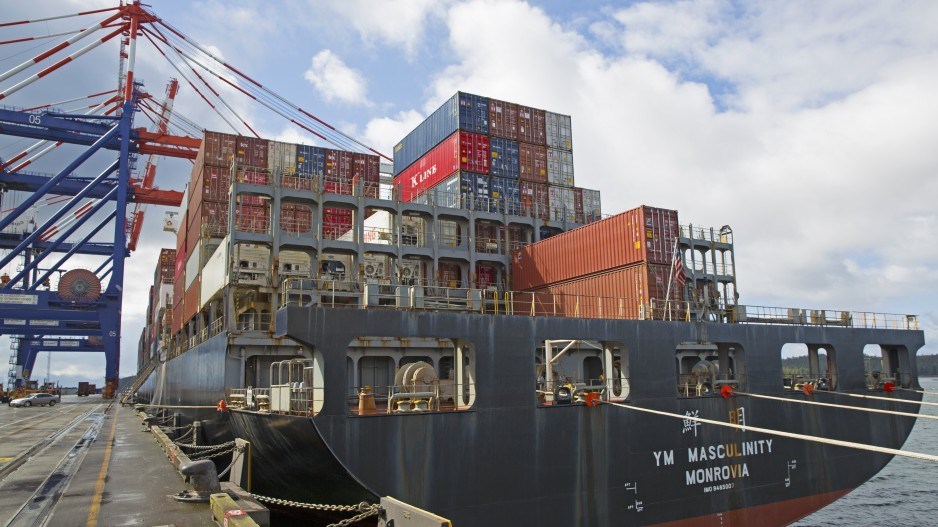Prince Rupert has added another major shipping line to its customer base.
Yang Ming (TPE:2609) and its partners in THE Alliance launched a new weekly call at the northern B.C. port’s Fairview container terminal on April 21 as part of its PS8 service from Asia to North America’s West Coast.
The new service will initially add an estimated 100,000 20-foot equivalent units (TEUs) per year to Fairview’s containerized cargo volume.
But the additional volume is only one side of the equation.
Shaun Stevenson, the Port of Prince Rupert’s vice-president of Trade Development and Public Affairs, said the win for the port in the addition of a fourth weekly container call at the northern port is “really about another service that represents market reach.”
Hapag Lloyd Hapag-Lloyd (ETR:HLAG) and Ocean Network Express are THE Alliance’s other partners. Its PS8 service originates in Tianjin, Qingdao, Busan and Shanghai, the world’s busiest container port. It makes other North American stops at Tacoma, Washington, and Los Angeles, California.
With the addition of THE Alliance, Prince Rupert is now serviced by all three of the world’s major container-shipping alliances, which were formed in 2017.
Prince Rupert, the closest major North American port to Asia, is one of the continent’s fastest growing container cargo ports. Container traffic through the port in 2017 was up 26% to 926,540 TEUs compared with 2016.
Last August, Fairview operator DP World [FRA:3DW] unveiled a $200 million expansion of the container terminal that increased its annual capacity to 1.35 million TEUs from 776,412. The project allows the terminal to handle the largest container cargo vessels being deployed in major freighter fleets.
Dubai-based DP World, which also operates Vancouver’s Centerm container terminal, has ambitions to increase its West Coast Canada cargo handling capacity to four million TEUs by 2022. Sixty per cent of that total would go through Prince Rupert as part of a third Fairview expansion that would raise its capacity to between two million and 2.5 million TEUs.
When it began operation in 2007, Fairview was North America’s first dedicated intermodal (ship to rail) container terminal. In its first year, it handled just over 16,000 TEUs.
Angela Kirkham, DP World Prince Rupert’s marketing and communications manager, said that, while it would be difficult to estimate the exact number of TEUs the new Yang Ming service will add to Fairview’s operation, it will help optimize use of the expanded terminal and accelerate the next phase of its expansion.
Yang Ming, the world’s eighth largest container line, has had financial challenges over the past few years.
While its financial results for 2017’s first half showed an 87% reduction in net loss compared with the same period in 2016, that loss was still US$44 million.
By year’s end, however, company finances were back in the black with a US$11 million profit on revenue of US$4.4 billion.
Prince Rupert’s expanded Fairview Terminal has also experienced teething problems.
Shortly after the official unveiling of the $200 million expansion in late August 2017, two major shipping lines temporarily diverted cargo from Prince Rupert south to the Port of Vancouver because of cargo-handling delays.
COSCO Shipping Holdings Co. Ltd. (HK:1919), a member of the Ocean Alliance, and A.P. Moller-Maersk’s (CPH:-MAERSK-B) Maersk Line, one of two partners in the 2M Alliance, began rerouting vessels south because Fairview’s container dwell times had ballooned to seven days. A reckoning of terminal cargo-handling efficiency, dwell time measures the average time a container sits on a dock after being unloaded from a ship and before it’s loaded onto railcars or trucks. Fairview’s average dwell time for containers had been approximately two days.
Stevenson said the congestion that caused the delays resulted from a surge in container cargo growth that hit Prince Rupert before the Fairview expansion had been completed.
“So we worked through those challenges with volume up by over 25% last year and through the fall as DP World completed the last elements of the project.”
Those elements included completing the rail lines on the terminal, which is serviced by CN (TSX:CNR).
“That caused congestion … and we continued to have record volumes, so together with CN we fought through the winter, but over past five to six weeks we have seen a return to the normal operations that we have come to enjoy in Prince Rupert.”
Stevenson added that dwell times have been reduced to less than two and a half days, “sometimes [under] two days, and we are up over 20% this year already.”
He pointed out that port dwell times vary, depending on the complexity of local transportation links and the size of local markets being serviced by container cargo. But Stevenson noted that dwell time targets at other competing ports are around four days or fewer, whereas Prince Rupert’s target is two and a half days or fewer.
“With all the volume that we’re seeing up and down the coast, it’s not unusual to see dwell times up in the eight, 10, 12-day [range] at other ports, especially on the U.S. west coast.”
He said the simplicity of Prince Rupert and its dock-to-rail operation makes it, under normal circumstances, extremely efficient in container cargo movement.
@timothyrenshaw




